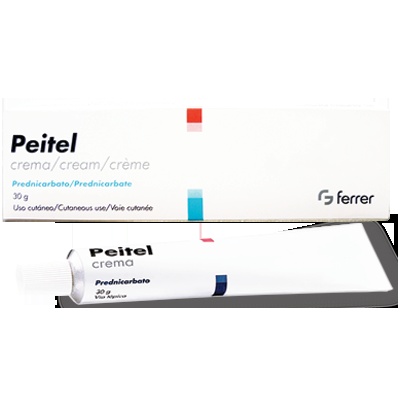

PEITEL 2.5 mg/g CREAM

Ask a doctor about a prescription for PEITEL 2.5 mg/g CREAM

How to use PEITEL 2.5 mg/g CREAM
Introduction
Package Leaflet: Information for the User
Peitel 2.5 mg/g Cream
prednicarbate
Read all of this leaflet carefully before you start using this medicine because it contains important information for you.
- Keep this leaflet, you may need to read it again.
- If you have any further questions, ask your doctor or pharmacist.
- This medicine has been prescribed for you only. Do not pass it on to others. It may harm them, even if their signs of illness are the same as yours.
- If you get any side effects, talk to your doctor or pharmacist. This includes any possible side effects not listed in this leaflet. See section 4.
Contents of the pack
- What is Peitel and what is it used for
- What you need to know before you use Peitel
- How to use Peitel
- Possible side effects
- Storing Peitel
- Contents of the pack and other information
1. What is Peitel and what is it used for
Peitel contains the active substance prednicarbate, and belongs to a group of medicines called topical corticosteroids. This medicine is used on the skin to reduce inflammation, allergic reactions, redness, and oozing in inflamed skin.
Peitel is indicated for the treatment of symptoms (redness and itching) caused by certain inflammatory skin disorders that respond to topical corticosteroid treatment, such as atopic dermatitis and psoriasis (excluding extensive plaque psoriasis).
2. What you need to know before you use Peitel
Do not use Peitel:
- If you are allergic to prednicarbate or any of the other ingredients of this medicine (listed in section 6)
- In the eyes, or on open wounds
- In areas of the skin that show a vaccination reaction, i.e. redness or inflammation after vaccination
- If you have tuberculosis, syphilis, or viral infections (e.g. chickenpox or herpes)
- In rosacea, acne, or skin thinning (atrophy)
- In perioral dermatitis (inflammation around the mouth).
Warnings and precautions
Consult your doctor or pharmacist before using Peitel.
- It should not be applied to large areas of the body or for a long period, as this significantly increases the risk of side effects. This medicine should be used in the lowest possible dose and only for the shortest necessary time to treat the skin condition.
- Avoid getting Peitel in your eyes, open wounds, or mucous membranes.
- If skin infections caused by bacteria or fungi develop, consult your doctor, who will establish additional specific treatment.
- If you use the medicine on skin folds (e.g. armpits or groin), you should be very cautious because it can increase the absorption of the active substance.
- This medicine should not be used under airtight and waterproof dressings, such as bandages or diapers.
- The use of topical corticosteroids in large areas or at high doses for a prolonged period increases the risk of side effects.
- If you are being treated for psoriasis, strict medical supervision is recommended.
- Sudden discontinuation of treatment should be avoided. When long-term treatment with a potent corticosteroid is discontinued, a rebound effect may occur, characterized by intense redness, itching, and burning.
- Non-professional use of topical corticosteroids can mask symptoms and make diagnosis and correct treatment more difficult.
- Avoid contact between Peitel and latex condoms, as it may cause leaks or breaks.
- Contact your doctor if you experience blurred vision or other visual disturbances.
Children
This medicine is not recommended for use in children under 2 years of age due to the lack of clinical data in this population.
In children, the use of topical corticosteroids should be done with caution, limiting the dose to the lowest effective dose.
Using Peitel with other medicines
Tell your doctor or pharmacist if you are using, have recently used, or might use any other medicines.
No interactions with Peitel are known; however, other preparations should not be applied to the area being treated.
Pregnancy, breastfeeding, and fertility
Pregnancy
If you are pregnant or breastfeeding, think you may be pregnant, or plan to become pregnant, consult your doctor or pharmacist before using this medicine.
There are no sufficient data on the use of Peitel in pregnant women.
In general, during the first trimester of pregnancy, medicines containing corticosteroids should not be applied to the skin.
Breastfeeding
The safety of Peitel during breastfeeding has not been established, so its use is not recommended. Breastfeeding women should not apply the medicine to their breasts.
Driving and using machines
Peitel has no influence or negligible influence on the ability to drive and use machines.
Peitel contains cetyl alcohol, stearic alcohol, and benzyl alcohol
This medicine may cause local skin reactions (such as contact dermatitis) because it contains cetyl alcohol and stearic alcohol.
This medicine contains 10 mg of benzyl alcohol per gram of cream. Benzyl alcohol may cause allergic reactions and moderate local irritation.
3. How to use Peitel
Follow exactly the administration instructions of this medicine given by your doctor or pharmacist. If in doubt, consult your doctor or pharmacist again.
This medicine is for external use only (to be applied to the skin).
The recommended dose is:
Adults and children over 2 years
Apply a thin layer of cream to the affected area once or twice a day, rubbing gently.
Treatment may be reduced to once-daily application when significant improvement is observed.
The duration of treatment should not exceed 4 weeks as a general rule.
If you use the medicine for a condition on the face, the duration of treatment should be as short as possible and no more than one week.
After each application, wash your hands unless they are the treatment area.
Use in children
Peitel is not recommended for use in children under 2 years of age due to the lack of safety data.
In children, the use of topical corticosteroids should be done with caution, limiting the dose to the lowest effective dose.
If you use more Peitel than you should
If you significantly exceed the recommended dose, systemic corticosteroid effects cannot be ruled out.
In case of overdose or accidental ingestion, consult your doctor or pharmacist or go to a medical center, or call the Toxicology Information Service. Phone: 91 562 04 20, indicating the medicine and the amount ingested.
If you forget to use Peitel
Do not apply a double dose to make up for forgotten doses.
Apply the corresponding dose when you remember, or wait until the next application if it is soon.
If you have any further questions on the use of this medicine, ask your doctor or pharmacist.
4. Possible side effects
Like all medicines, this medicine can cause side effects, although not everybody gets them.
The side effects of prednicarbate are generally local, mild, and transient. As with other topical corticosteroids, long-term use of large quantities or treatment of extensive areas may lead to systemic corticosteroid effects due to absorption. If this occurs, topical treatment should be discontinued.
The possible side effects that may occur with this medicine are listed below by frequency:
Common side effects (may affect up to 1 in 10 people)
Skin and subcutaneous tissue disorders:
- mild to moderate burning sensation at the application site
- tingling sensation (paresthesia)
- itching (pruritus)
- bacterial infections
- furunculosis
- local skin thinning (atrophy)
Uncommon side effects (may affect up to 1 in 100 people)
Skin disorders:
- striae
- irritation
- hair growth on the skin (hypertrichosis)
- skin discoloration (hypopigmentation)
- perioral dermatitis
- skin maceration
- allergic contact dermatitis
- rosacea-like dermatitis (facial skin)
- acne-like reactions
- capillary fragility (ecchymosis)
- red or white bumps on various parts of the body (miliaria)
- skin dryness
- folliculitis
Infections:
- secondary infection
Rare side effects (may affect up to 1 in 10,000 people)
Vascular disorders:
- telangiectasia (dilation of skin blood vessels or spider veins)
Side effects with unknown frequency (cannot be estimated from the available data)
Eyeball disorders:
- blurred vision
Other side effects in children
Children and adolescents may demonstrate a greater susceptibility than adult patients to suppression of the hypothalamic-pituitary-adrenal axis and Cushing's syndrome induced by topical corticosteroid use, due to a greater surface-to-weight ratio. Chronic therapy with topical corticosteroids may interfere with growth and development in children.
Intracranial hypertension has been reported in children treated with topical corticosteroids. Manifestations of intracranial hypertension include bulging fontanelles, headaches, and bilateral papilledema.
Reporting of side effects
If you experience any side effects, talk to your doctor or pharmacist. This includes any possible side effects not listed in this leaflet. You can also report side effects directly to the Spanish Medicines and Healthcare Products Agency (AEMPS) at www.notificaram.es. By reporting side effects, you can help provide more information on the safety of this medicine.
5. Storing Peitel
Keep this medicine out of the sight and reach of children.
Do not use this medicine after the expiry date which is stated on the packaging after EXP. The expiry date is the last day of the month stated.
Store below 25°C.
Medicines should not be disposed of via wastewater or household waste. Return all unused medicines to a pharmacy for proper disposal. Ask your pharmacist how to dispose of medicines no longer required. This will help protect the environment.
6. Contents of the pack and other information
Composition of Peitel:
- The active substance is prednicarbate.
Each gram of cream contains 2.5 mg of prednicarbate
- The other ingredients (excipients) are: octyldodecanol, liquid paraffin, stearic alcohol, cetyl alcohol, myristic alcohol, sorbitan stearate, polysorbate 60 (E-435), benzyl alcohol, disodium edetate, and purified water.
Appearance and packaging of the product
Peitel is a uniform cream with a creamy consistency and white color.
It is available in aluminum tubes containing 30 and 60 grams of cream.
Other presentations:
Peitel 2.5 mg/g ointment and Peitel 2.5 mg/g cutaneous solution.
Marketing authorization holder:
Galenicum Derma, S.L.U.
Ctra N-1, Km 36
28750 San Agustin del Guadalix (Madrid)
Spain
Manufacturer:
Ferrer Internacional, S.A.
Joan Buscallá, 1-9
08173 - Sant Cugat del Vallés (Barcelona)
Spain
Date of last revision of this leaflet: January 2021
Detailed information on this medicine is available on the website of the Spanish Agency for Medicines and Healthcare Products (AEMPS) (http://www.aemps.gob.es/).

How much does PEITEL 2.5 mg/g CREAM cost in Spain ( 2025)?
The average price of PEITEL 2.5 mg/g CREAM in November, 2025 is around 5.06 EUR. Prices may vary depending on the region, pharmacy, and whether a prescription is required. Always check with a local pharmacy or online source for the most accurate information.
- Country of registration
- Average pharmacy price5.06 EUR
- Active substance
- Prescription requiredYes
- Manufacturer
- This information is for reference only and does not constitute medical advice. Always consult a licensed doctor before taking any medication. Oladoctor is not responsible for medical decisions based on this content.
- Alternatives to PEITEL 2.5 mg/g CREAMDosage form: CREAM, 0.250 g prednicarbate / 100 gActive substance: prednicarbateManufacturer: A. Menarini Latin America S.L.Prescription requiredDosage form: OINTMENT, 0.25% prednicarbateActive substance: prednicarbateManufacturer: A. Menarini Latin America S.L.Prescription requiredDosage form: OINTMENT, 0.25% prednicarbateActive substance: prednicarbateManufacturer: A. Menarini Latin America S.L.Prescription required
Alternatives to PEITEL 2.5 mg/g CREAM in other countries
The best alternatives with the same active ingredient and therapeutic effect.
Alternative to PEITEL 2.5 mg/g CREAM in Ukraine
Online doctors for PEITEL 2.5 mg/g CREAM
Discuss dosage, side effects, interactions, contraindications, and prescription renewal for PEITEL 2.5 mg/g CREAM – subject to medical assessment and local rules.






